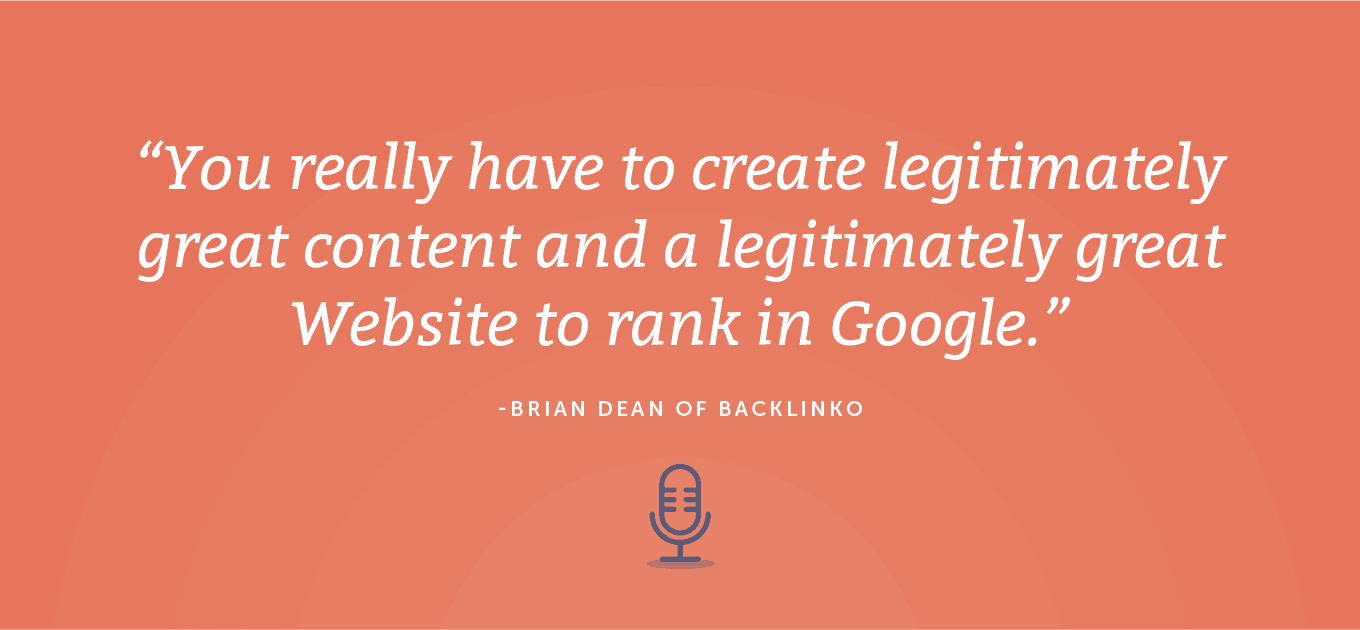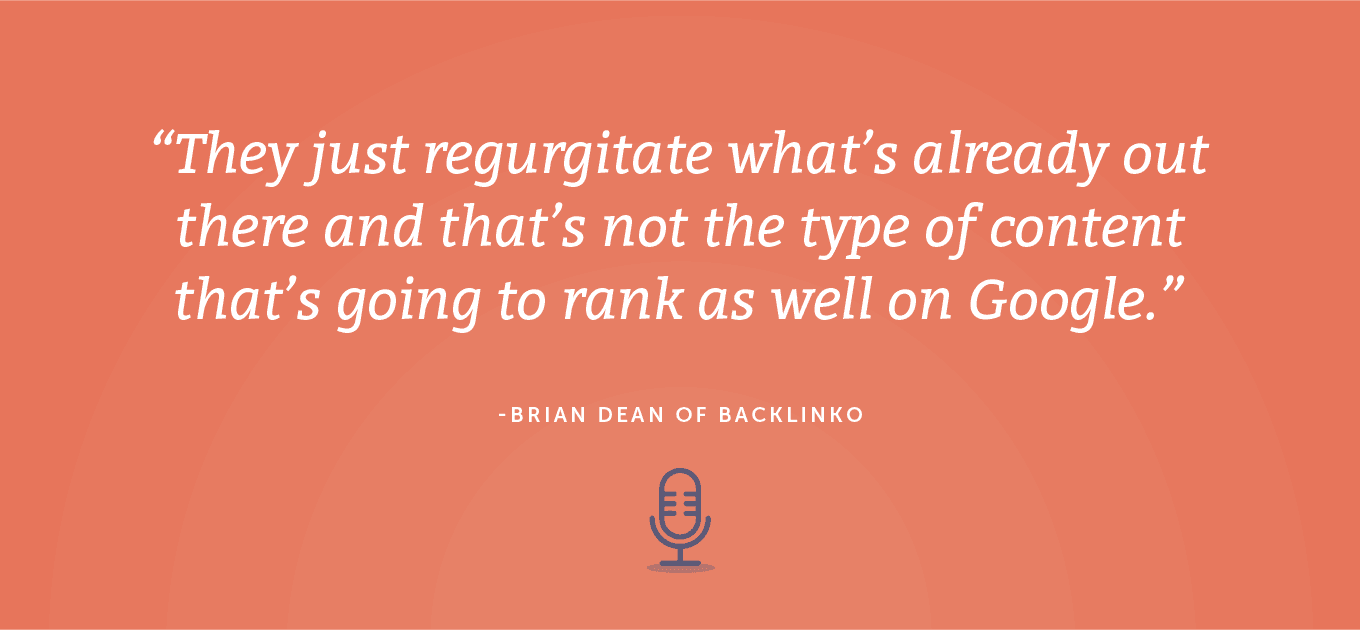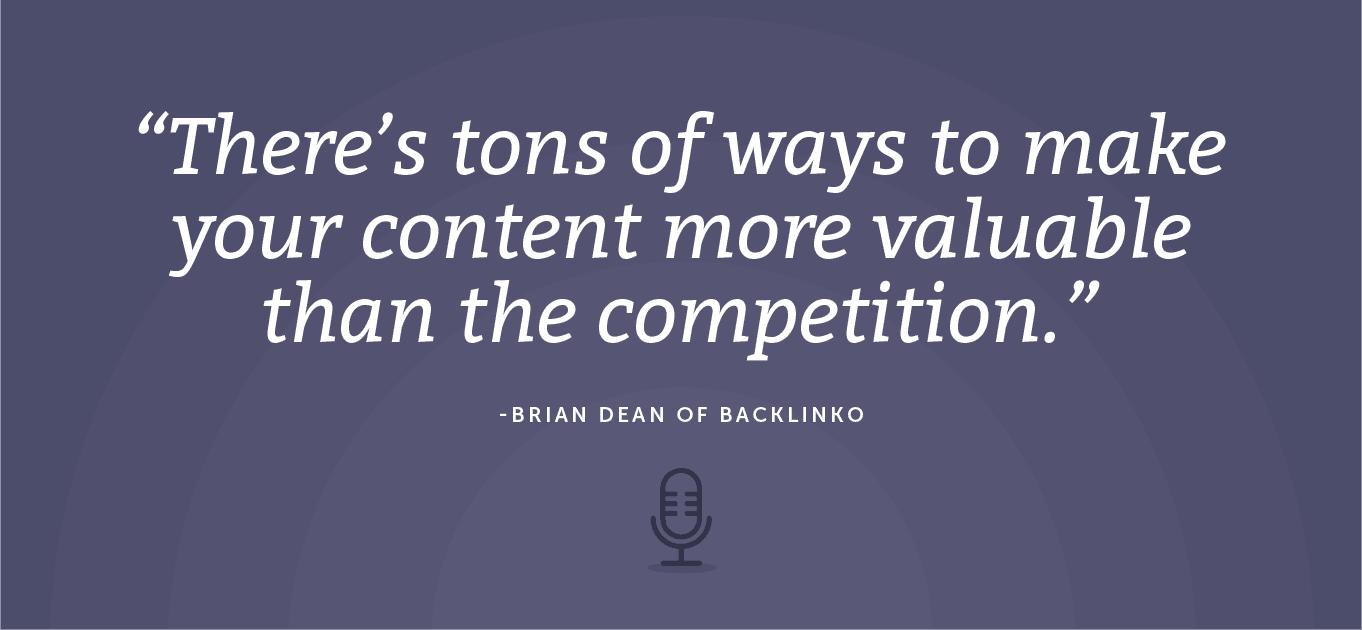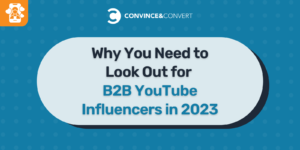CoSchedule started the Actionable Marketing Podcast (AMP) in 2015 and has recorded and published more than 300 episodes. CoSchedule has worked with some of the smartest minds out there that share their stories with you through this podcast. This season, CoSchedule brings back some of the best of the best evergreen content.
These days, you need to create both a great Website and great content to rank on Google.
Today, we’re talking to Brian Dean, an SEO expert and founder of Backlinko, about how to fuel your 10x content using his research method called the Skyscraper Technique.
[podcast_motor_player url=https://traffic.libsyn.com/secure/coschedule/Best_of_Season_AMP_082__How_To_Drive_10x_More_Traffic_With_This_SEO_Technique_From_Brian_Dean_Of_Backlink.io.mp3]
Some of the highlights of the show include:
- Black Hat SEO: Stuffing keywords and creating fake signals to rank in Google
- Google penalized sites using Black Hat SEO strategy
- White Hat SEO: Show Google everything you did to optimize your site
- Backlinko teaches people White Hat SEO strategies
- SEO Elements: Keyword and topic research; create content around them
- Two types of keywords: Information and commercial
- Create and optimize content that gets the most searches around keywords/topics
- Differences between well-researched and not researched content and topics
- Provide one-stop shopping for all the information customers need
- Skyscraper Technique: Research to figure out what content will perform well
- Ways to improve content – go bigger and better, curate, storytelling, and more
- Focus on quality over quantity; create less content, make it more valuable
- Common missteps when implementing “less is more” strategy and ranking
Links:
- 10X Marketing Formula by Garrett Moon
- Backlinko
- Backlinko on YouTube
- Jon Cooper
- Tim Ferriss and the 4-Hour Work Week
- Google Keyword Planner
- CoSchedule
If you liked today’s show, please subscribe on iTunes to The Actionable Content Marketing Podcast! The podcast is also available on SoundCloud, Stitcher, and Google Play.
Quotes by Brian Dean:
- “You really have to create legitimately great content and a legitimately great Website to rank in Google.”
- “Everything starts with a keyword with SEO.”
- “They just regurgitate what’s already out there and that’s not the type of content that’s going to rank as well on Google.”
- “There’s tons of ways to make your content more valuable than the competition.”
AMP Best of Season: How To Drive 10x More Traffic With This SEO Technique From @BrianEDean Of @backlinko
Click To Tweet
Transcript:
Garrett: Hey everyone, it’s Garrett again and welcome to another 10x Marketing Formula exclusive interview. Today I have the pleasure of hosting Brian Dean. Brian is the founder of Backlinko and is an internationally recognized SEO expert who’s worked with companies like Disney, Apple, IBM. Today we’re going to be talking about how to fuel your 10x content with a research method that Brian developed called the skyscraper technique, and I’m really excited to have him on the show I guess. Welcome Brian.
Brian: Thanks Garrett. Good to be here.
Garrett: Why don’t we just start giving us a little bit of background on yourself and how you got into SEO, and kind of where it’s taken you so far.
Brian: When I first got into SEO, SEO was completely different. I launched my first website in 2008, and that’s basically when I learned what SEO stood for. I was really new. Back then you could game the system and rank in Google. Today as we’ll learn you really have to create legitimately great content and legitimately great website to rank in Google, but during this brief point of time from 2008 to 2012 it didn’t actually make sense to do that. It made more sense to game the system. When I say game the system, I mean artificially stuffing keywords into your content and creating fake signals for Google so then they rank you. That’s when I first got into it. That was all the rage. That’s called black hat SEO. I was doing black hat SEO. That’s all I did all the time for like four years. Google eventually got smarter about having this stuff not work anymore and specifically penalizing websites that did this stuff. Then their results would be more high quality and be based on merit as opposed to who could game the system the most. After a lot ups and downs of creating some black hat sites that would get penalized and basically eliminated from Google search, creating another set of sites, a different strategy this time, those would get eliminated. Eventually I got fed up with this whole cat and mouse game with Google and I decided to create a real website that was actually good and use legitimate strategies to rank it. I did that in the summer of 2012. The site grew super fast. It got from zero to tens of thousands of visitors a month within 90 days and that’s when I realized, “Wow, there’s something to this white hat SEO thing. Maybe instead of reading about black hat SEO stuff all the time, I should read about white hat SEO and learn about that.” But when I went to a blog that talked about white hat SEO there wasn’t a lot of actionable content there. It was mostly higher level fluff like create great content, create a great website, promote your content, but there wasn’t anything specific like how do you create great content or how do you promote your content. I realized there was a gap in the market there and that’s when I launched my blog Backlinko, which is designed to fill in that gap and teach people actionable white hat SEO strategies. Even today there aren’t so many sites doing it, but at the time it was able to grow quickly because there were a lot of people like me who were transitioning from the gaming the system to white hat and they didn’t really have a resource to find what they should actually do, and that’s when, that’s where Backlinko filled in the gap and it’s been great.

Garrett: It is great. Backlinko has been a subscriber list for our team for years because you do a great job of filling in that gap, and I think you’re one of the best, and we always, always enjoy following you. One of the things that I kind of think about in there is you’re talking about black versus white hat SEO. I think that black hat that you talk about is still sort of the misconception or it’s sort of still how people think about SEO, particularly content creators or content marketers in some cases. Specifically to a content creator, somebody who’s already creating marketing based content, how would you explain what white hat SEO is and even some of the misconceptions that they still carry with that?
Brian: I think the best definition of white hat SEO I’ve ever heard was from my friend John Cooper who is a link building expert. He said, “White hat SEO is where you wouldn’t mind showing Google everything you did to optimize your site. Black hat is where you would have some stuff you wouldn’t be so proud of to show them.” In other words, with black hat SEO you might be creating content but then you keyword optimize it to a point where actually hurts the readibility of the content. That’s probably not something you’d show Google that you did, versus white hat, you’re like, “Hey, I found this topic.” I used keywords around that topic and it created a great piece of content that helps people on this topic. That’s more white hat SEO. There’s a lot more to black hat SEO like black hat links and all this stuff, but most people that are creating content aren’t into that stuff because it just doesn’t work as well anymore. There are still some people that are trying to hang on to the old days, but for most people that’s the distinction that no matter what changes in SEO that will always be true.
Garrett: Excellent. So what are some of the most important elements in that, in white hat SEO techniques?
Brian: The first element is before you write a word is keyword research and topic research. No matter how SEO changes in the future, search will always start with a keyword, whether it’s someone typing into their browser, whether it’s someone using a voice search on their phone, everything starts with a keyword with SEO. The key is to find keywords that your target customer is searching for. For example, my company Backlinko sells SEO training products, so a big customer base of mine are like SEO agencies and bloggers. So I find keywords and topics that these people search for in Google and then I create content around those topics. That’s honestly like 75% of the game. If you do that right and not just understand keywords but understand what these people need and then fulfill that need, Google will kind of take care of the rest. Now they’re not perfect and it’s not like you can just create great content and rank any … That’s not true either. But when you create awesome content that’s well researched and fills a need of your target audience, Google is smart enough to start to rank you. As time goes on, as Google gets smarter, the best content is going to bubble to the top, and if you create that which requires a lot of research you can get there.

Garrett: Talk to me a little bit about that research. What do you mean specifically when you say it? What does that look like?
Brian: I’ll just walk you through the process. The first step is to have a list and just brainstorm topics that your target customer would search for in Google when they’re searching for information. It’s basically two types of keywords. You have commercial keywords and you have information keywords. Commercial keywords for Coschedule is like social media software and social media management tools and that’s stuff that customers are searching for sometimes with their credit card in their hand and they want to buy. There is a point and a ranking for these, but there are very limited number of keywords and they’re very competitive, so a lot of times it makes more sense to create content around informational keywords and rank for tons of those, get tons of traffic, and then a small percentage will convert into customers and leads. Even though it’s a small percentage you can get a lot more traffic from that strategy and you can grow your company that way. Well I have. Coschedule is a great example. Mine too. Let’s take out the commercial keywords for a second because those are pretty simple. It’s basically whatever you sell. For informational keywords it’s a little bit more nuanced because you have to get inside your customer’s head and think what are they searching for when they’re not searching for my product or service, and then list out all the different topics they would search for. You can also do more research rather than just guessing. You can talk to customers, ask them what websites they visit when they’re not visiting your site. For example, in the affiliate marketing community there’s a lot of people who follow The Four Hour Week by Timothy Ferriss and other books like that. It’s not related to affiliate marketing, but it’s something that they would search for in Google. Or someone for example who is looking to lose weight, they’re not just searching for weight loss. They’re also searching for workouts and a paleo diet and kettle bells and things like that. If you sold like a weight loss plan, you’d come up with these other topics that your customers are searching for. You can talk to them. You can also go to subreddits on Reddit where people tend to hang out and discuss it or online forums and just list out all these topics. They should be related to what you sell, but they don’t have to be the exact thing. Then it’s a matter of finding out if people actually search for these keywords. There are tons of tools for this, but the easiest one and it’s also free is the Google Keyword Planner, which is Google’s own tool. You can type those topics into Google and then see which of the how people actually phrase them when they type them into Google. You want to optimize your content around those that get the most searches. Now there’s a lot more to keyword research. You can do an entire … There are books on it. There’s a lot of other things to consider, but that’s basically the process. Then it’s a matter of creating the best content around that keyword, and if it’s really the best and you promote it, it can rank high in Google.
Garrett: I love it. I think one of my favorite tips there is just the comment to go look on Reddit or just discussion forums. I think that’s one of the places where you find some of the richest keywords because you hear potential customers or audience members actually just using their own language and it kind of juggles the mind a little bit because I think it’s, I think just sometimes finding the keywords and like what are some of those topics outside of your immediate influence of what you’re selling can be really hard to do. That’s a great tip. What would you say the difference is between a piece of content that’s well researched and one that’s not researched very well?
Brian: Well there is the content itself and the topic. Do you mean the content itself or both?
Garrett: Well, maybe both. I think I was thinking content in itself, but I think which is kind of interesting there, maybe go both.
Brian: The difference is that they kind of feed off each other. If you research your audience and you know what they need and you create content that fits it, part of the research is figuring out what these people want. For example, for my site, my target audience, they love comprehensive guides. There is tons of content in the marketing space as you know Garrett that’s like five tips of doing whatever, 10 ways to do blank, and it’s just doesn’t really help people. If you want for example get more views on YouTube, you don’t really want 10 tips or five tips. You want the guide. You want one place that has all the information there. After you do your keyword research and you figure out, “Okay, a lot of my customers are YouTubers and they want to get more views, I need to create content that helps them get more views.” That’s the research right there. You’ve already done a great job identifying that. Then it’s a matter of figuring out how do I create content that will actually fit their needs. It depends on the niche. In some industries five tips might work better than a guide since some people may just want the answer right away. But in our industry where something is … it’s actually hard to get YouTube views, you don’t want to go from like blog post one to blog post two to blog post three and then try to put the pieces together. One stop shopping is really important. If they land on a guide and have all their answers in one place, that’s going to do well. It takes a lot of research to figure out what the person will actually want and also how do people get YouTube views. You need to know that stuff in order to teach someone. That’s a step a lot of people skip because they just regurgitate what’s already out there. That’s not the type of content that’s going to rank as well in Google versus coming up with something original or giving tips that people don’t know before or curating it in a unique way, providing value. That is a huge part of the research process, is figuring out how to actually solve that person’s problem and write it up in a way that people will be able to take action on it.

Garrett: Excellent. That’s really good. When it comes to research, one of the things that I’ve always been interested in is what you call the skyscraper technique. Can you tell us a bit about kind of what that technique is and how you went about developing it?
Brian: Yeah, so the skyscraper technique is one of the best ways to figure out what content is going to perform well. It’s just a form of research. The step by step process is first you find a keyword that you want to rank for, which you’ve already done. Then you want to search for that keyword in Google to see what’s already out there, because when it comes time to publishing your content or ranking it, that’s going to be your competition so it’s important to know what you’re competing against before you start. Then it’s a matter of creating something that’s better than what’s already on the first page. The way I developed it was I had created content for a client a few months before I had really fully developed a technique and it used that strategy and we did really well with it. Then when I started Backlinko, the SEO space that I’m in is super competitive, really hard to break through. I didn’t know anybody. I was just starting out. So I knew I needed to create a piece of content that would really stand out. I wanted to list out all of Google’s 200 ranking factors. They confirmed like a year before that they used 200 ranking factors. Now I knew of course this wasn’t going to be like an official list or anything because I’m not going to reveal all 200, but I could curate from around the web the 200 potential ranking factors that there could be. When I searched for keywords like Google ranking factors or Google’s 200 ranking factors, I noticed that most of the content out there only listed like 100 or 120. No one actually hit the number 200. That’s when I realized that I could create something better or create a higher skyscraper than what was out there. When I did that piece of content did great, it still does great, and it was one of the ways that I was able to get my blog in a very competitive space on the map.
Garrett: That’s awesome. What are some other ways that people can think about that in terms of making their content better? You kind of did this with the full list of 200. Are there other methods or other ways that you approached that same concept?
Brian: Definitely. The easiest way and the most straightforward is just to create something bigger and better. If you have, if everyone has a list of 50 tips, you can create a list of 100. At some point though it doesn’t really make sense to do that, it can just get ridiculous, and it actually doesn’t necessarily provide more value because maybe 200 tips is overwhelming, and maybe 10 highly curated tips that are in depth will work better. That’s where the research comes in where you’ve got to, you think of the person searching for this term in Google and think what do they actually want. Are 200 tips really going to help them more than one tip that’s going to be really in depth and going to walk them through? Improving isn’t always bigger and better, but it is one way to do it and often is the best way to do it, for example, to be more comprehensive. In my case, the Google 200 ranking factor post it was more comprehensive than the others. For example, if you wanted to help people get more YouTube views, putting all the tips from around the web and also some of your own in one place, curating it and into guide, one stop shopping, that’s another way to add value. Also, just straight up curating. If someone’s searching for resources on how to clean their kitchen better, you can curate the best content from around the web, put that in one post, and that can be a way to add value. Also, design is a way to make your content more value. If everyone just has a standard blog post template, you can include visuals like graphs, charts, videos, infographics to make your content standout and look better and that’s a way to add value. You can you story telling a case study. If everyone is just talking about generic tips and not giving any examples, you can give a case study about how someone used your tips to actually get results. It’s a way to be more valuable. There are tons of ways to make your content more valuable than the competition. That’s way more important than creating content for the sake of creating content, which is what unfortunately most content marketers and SEO people recommend. They say, “You just need to create a lot of content,” but in my experience the best way to rank is to create less content but make it more valuable using some of the strategies that I just outlined.

Garrett: I think what I really love about that technique is that, and some of that I talk about in the book a lot is that a lot of times we think about marketing content and just something that we execute, the thing that we create. But what’s really important for marketers, particularly marketers creating content, is you have to start seeing your content as being in competition with other content on the web, which is what makes SEO so important. I guess that mindset, that sort of your content in competition with the others is what the skyscraper technique goes about solving. And why do you think that’s so integral to actually seeing results?
Brian: Well because the mistake I made early on was I’d find a keyword and I would create a good piece of content around that keyword and then I’d move on to the next piece of content and thinking that the more, if I created enough content some day I would start to get traffic from Google. But I quickly learned that doesn’t really work. When I realized that every piece of content that I create is competing with hundreds of pieces of content, but specifically 10 on the first page, it helps you step up your game because you realize that, man, if I produce something that’s the 12 best piece of content about this topic, guess where I’m going to rank, number 12. If I create the first, I have a good chance of ranking number one. It just helps you mentally step up your game about content and focuses more on quality over quantity, which is in many ways the secret to succeeding with content marketing and SEO.
Garrett: Love that. What would be some of the common missteps that people make when implementing this strategy?
Brian: I think one of the common missteps is overrating their own content and underrating the content that’s already on the first page. A lot of people email me. They’re like, “Brian, why am I not ranking? The content above me it’s so much worse than mine. They have fewer links than me. They don’t have keywords optimized. Why am I not ranking?” I think it’d good to take a step back and be like, “Look, of course just like our kids are the best and the prettiest and the most handsome, our content is going to appear the same way through these rose colored glasses, and the competition who you hate, their content is going to suck.” It’s just like human nature that that’s how we’re going to view things. But obviously something’s missing if you’re not ranking. It’s not necessarily the content. It could be that you haven’t promoted it enough. It could be that your content is better. But in many cases when I actually look at the pieces of content that the person is saying is ranking above them versus theirs it is better in a lot of ways. Say a misconception is that the content is better, but also how much better it has to be. It just like a new product. If you create a product that’s 5% better than what’s out there, it’s not really enough to galvanize people and get them to share and get them to link to it and get them to buy it. It’s the same thing with content. If you create something that’s 5% better than what’s out there, it’s not really enough for to rank above what’s already entrenched on the first page. Because the pieces of content that are on the first page already have a huge advantage over you. They’re already there. They’re usually bigger brands and considering links pointing to a page or it’s such an important ranking factor for Google simply ranking in the top three helps you get more links because more people are seeing your content, and this cycle, this virtuous cycle continues where you rank, you get more links, which helps you rank and you get more links. You don’t have that advantage. Your content needs to [inaudible 00:20:19] what’s out there out of the water in order to outrank these entrenched competitors. I’d say another thing is you’ve got to create content that’s way better than what’s out there. It can’t just be a little bit, and that’s going to help you a lot. The third is that you have to promote your content. Even if your content is amazing, if you just publish and pray as I call it, it’s not going to work out. It’s something, a mistake I made early on with my first blog, which is in the weight loss space. I just produced tons of content that was actually pretty good, but I never promoted it. I never used email outreach. I never build links to it. I never paid, used Facebook ads. I never used AdWords to promote it. I just put it out there hoping that the Google gods would figure my content was the best and eventually rank it. Even if your content is great and outstanding, it still needs to be promoted strategically for you to get results.
Garrett: That’s fantastic. Tons of good stuff. I think SEO is one of those topics where there’s always more to learn, and one of the best places to do that is definitely Backlinko. Brian, if our listeners want to learn more about the skyscraper technique or other stuff besides the blog is there other places to get a hold of you and to read your stuff?
Brian: Yeah, I would definitely head over to backlinko.com. Like you said, there’s a ton of free resources there than can help people learn a lot more about this whole process, and also check out my YouTube channel. If you just go to YouTube and search Backlinko, you can see a lot of videos and I have exclusive content there. That’s about SEO and content marketing that I don’t publish on the blog.
Garrett: Yeah, great videos. You’ll watch one right after another. They’re really good stuff and you get right to the point.
Brian: Thanks man.
Garrett: All right, Brian. It’s been great talking to you. I really appreciate you digging into skyscraper technique for us today. Thanks for being on the show.

The post [Best of Season] How To Drive 10x More Traffic With This SEO Technique From Brian Dean Of Backlinko [AMP 278] appeared first on CoSchedule Blog.

![You are currently viewing [Best of Season] How To Drive 10x More Traffic With This SEO Technique From Brian Dean Of Backlinko [AMP 278]](https://www.dimaservices.agency/wp-content/uploads/2022/03/278_Brian-Dean-Podcast-Graphics_header.png)


